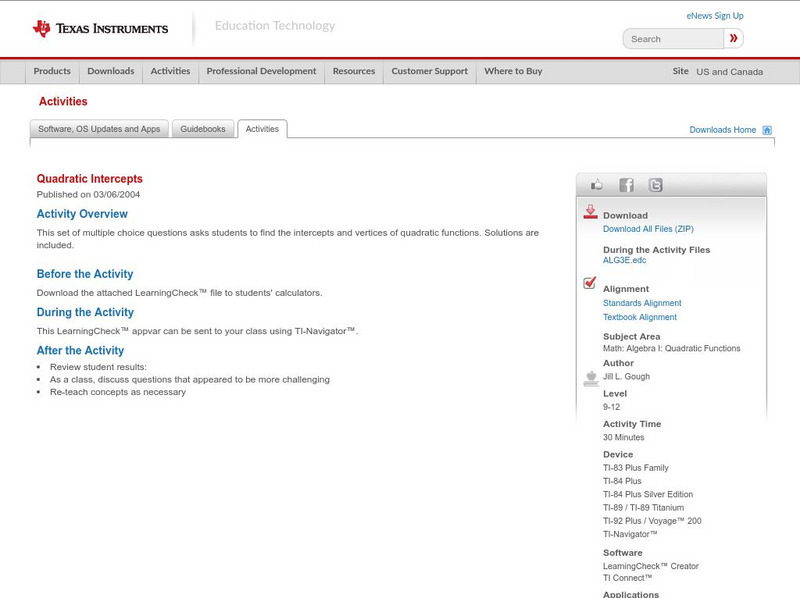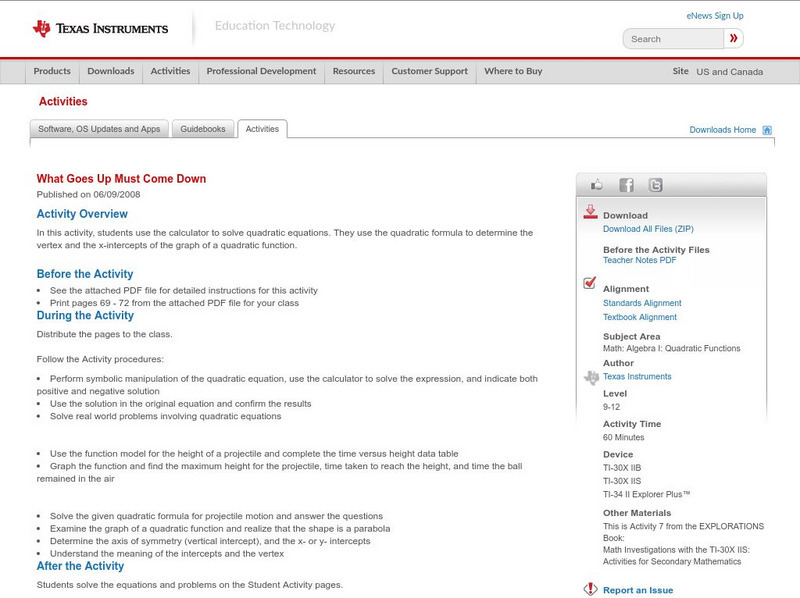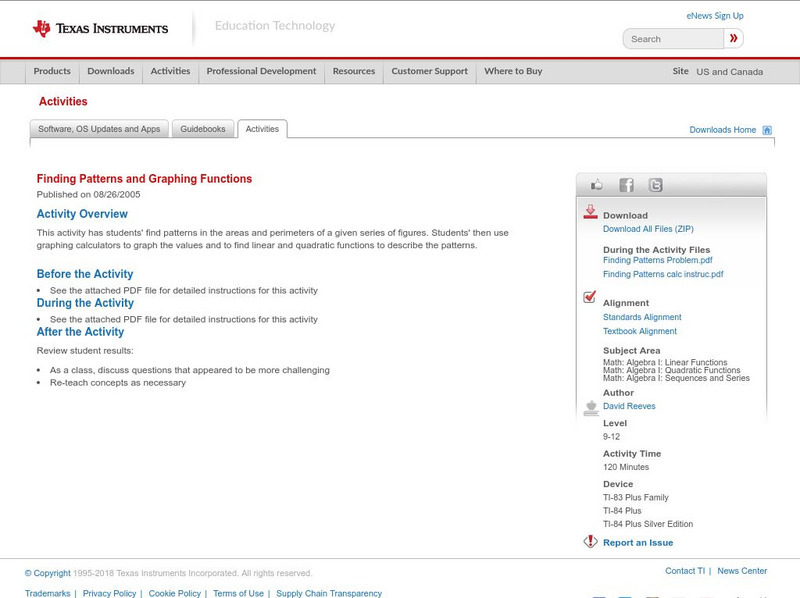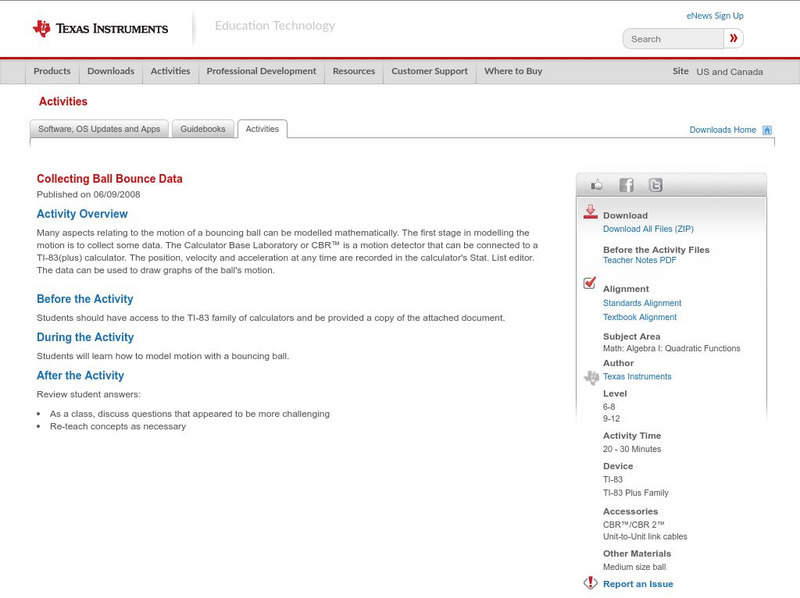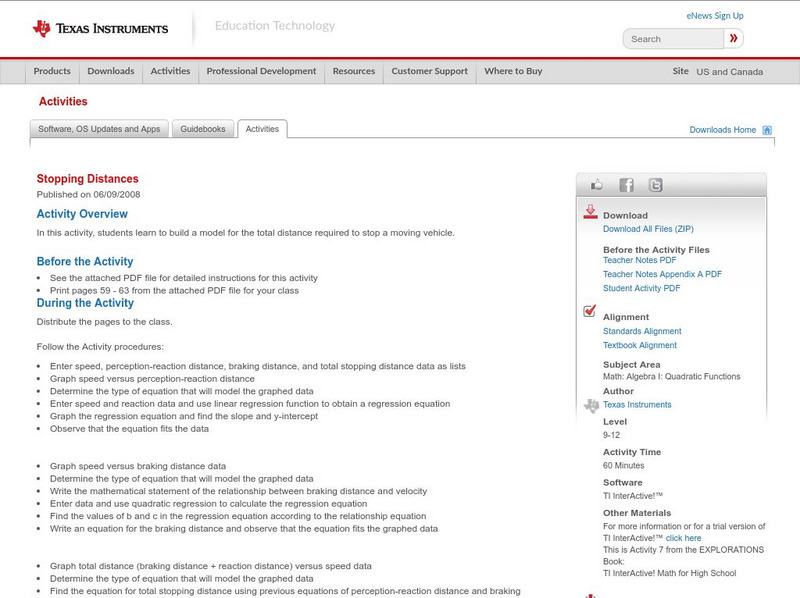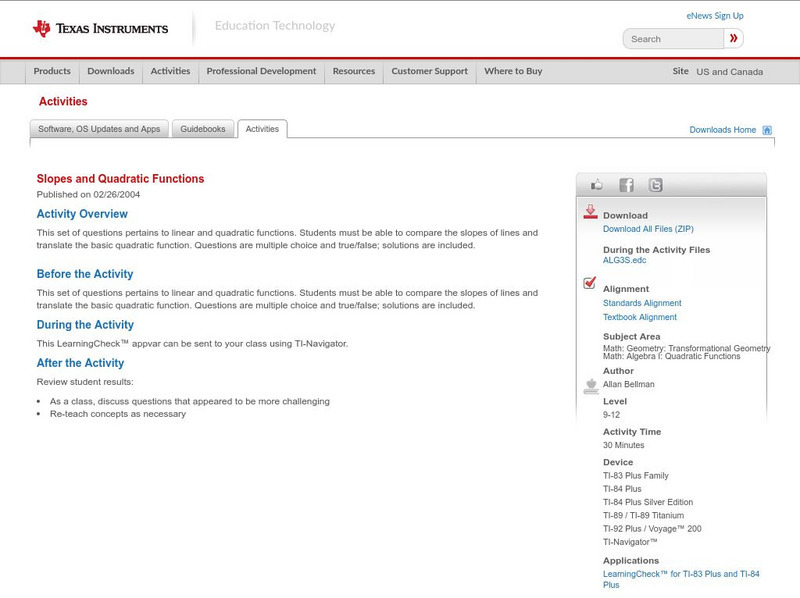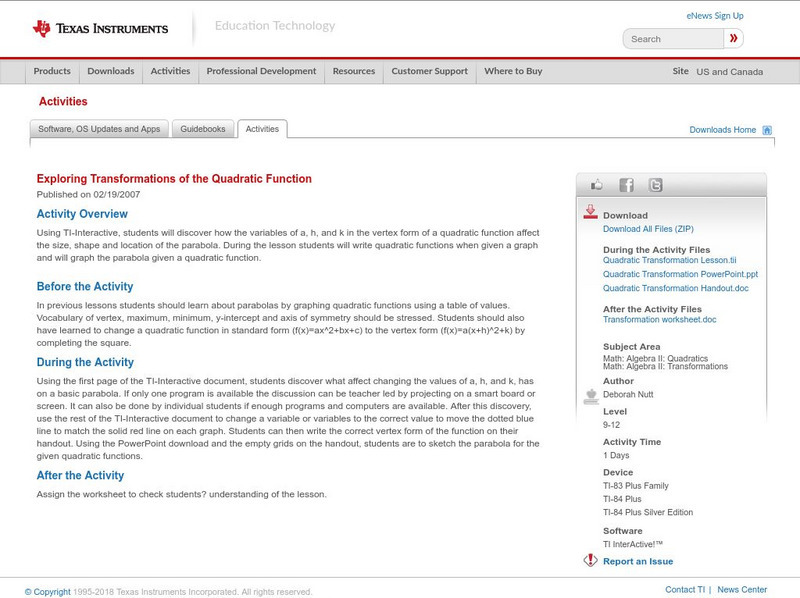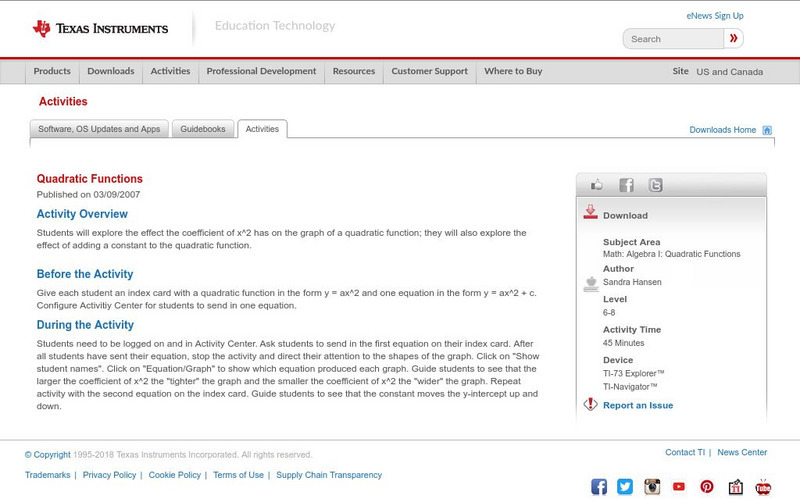Hi, what do you want to do?
Texas Instruments
Texas Instruments: Quadratic Intercepts
This set of multiple choice questions asks students to find the intercepts and vertices of quadratic functions. Solutions are included.
Texas Instruments
Texas Instruments: What Goes Up Must Come Down
In this activity, students use the calculator to solve quadratic equations. They use the quadratic formula to determine the vertex and the x-intercepts of the graph of a quadratic function.
Texas Instruments
Texas Instruments: Exploring Standard Form of a Quadratic Function
Students explore y=ax^2+bx+c using the transform graphing application. Teacher calculator is used with Navigator to send device settings, the equation format and initial coefficient values to all students. Worksheet includes all student...
Texas Instruments
Texas Instruments: Curve Ball
In this activity, students collect data for a bouncing ball using a motion detector. They analyze the data and attempt to find a model for the height of the ball as a function of time.
Texas Instruments
Texas Instruments: Standard Form of a Parabola
This activity will help students work with the standard form of a parabola y = a(x - h)^2 + k by writing an equation given the vertex and a point.
Texas Instruments
Texas Instruments: Ball Bounce
This activity allows students to use real data obtained by them to model quadratic equations. students can use the TI-83 and/or TI-84 and a motion detector to collect their data. The students will then manually fit both quadratic and...
Texas Instruments
Texas Instruments: Wrapping It All Up
Students recognize the effects of changes in parameters on the graphs of linear, quadratic, and exponential functions.
Texas Instruments
Texas Instruments: Graphing Families of Quadratic Functions
Students can use the Transform app to explore families of quadratic functions. Generalization about the effect of a, b and c coefficients have on the shape and position of the graph in general form, and the effect of a, h, and k in...
Texas Instruments
Texas Instruments: Writing Equations of Parabolas in Vertex Form
Students use their knowledge of the vertex form of a quadratic equation to graph parabolas, given a specific move to make.
Texas Instruments
Texas Instruments: Finding Patterns and Graphing Functions
This activity has students find patterns in the areas and perimeters of a given series of figures. Students' then use graphing calculators to graph the values and to find linear and quadratic functions to describe the patterns.
Texas Instruments
Texas Instruments: Vernier a Speedy Slide With Easy Data App and Cbr 2
Students can use a CBR 2 motion detector to determine their speed or velocity going down a playground slide. They will also experiment with different ways to increase their speed going down the slide.
Texas Instruments
Texas Instruments: Collecting Ball Bounce Data
Many aspects relating to the motion of a bouncing ball can be modelled mathematically. The first stage in modelling the motion is to collect some data. The Calculator Base Laboratory or CBR is a motion detector that can be connected to a...
Texas Instruments
Texas Instruments: Stopping Distances
In this activity, students learn to build a model for the total distance required to stop a moving vehicle.
Texas Instruments
Texas Instruments: Velocity and the Bouncing Ball
In this activity, students will explore the position of a ball versus time for a single bounce. They will also examine the relationship between the height of the ball and its velocity.
Texas Instruments
Texas Instruments: Math Today Challenge Heat Watch
Students will explore linear & quadratic functions to determine how they model the relationship between air temperature & heat index. Once the models are determined students will make predictions about heat index when given a...
Texas Instruments
Texas Instruments: Slopes and Quadratic Functions
This set of questions pertains to linear and quadratic functions. Students must be able to compare the slopes of lines and translate the basic quadratic function. Questions are multiple choice and true/false; solutions are included.
Texas Instruments
Texas Instruments: Quadratic Function Investigations
Use the interactive activity below to explore the effect of the parameters a,h,and k on the graph of the general quadratic function f(x) = a(x - h)^2+k.
Texas Instruments
Texas Instruments: Car Stopping Distances
This activity uses the tranformation graphing application on the TI-84 calculator to discover the equation for the stopping distance of a car on dry pavement.
Texas Instruments
Texas Instruments: The Bouncing Ball
In this activity, students will graph the height of a ball versus time after it is dropped from some height. They will then examine one ball bounce and investigate the parameters that effect the shape of the graph. They will also explore...
Texas Instruments
Texas Instruments: Math Today for Ti Navigator System Humidity Makes Air Feel
Using data from the USA TODAY graphic,"Humidity makes air feel even hotter," students will explore quadratic and cubic functions to determine how well they model the relationship between air temperature and heat index. When the models...
Texas Instruments
Texas Instruments: The Discriminant
In this set of questions, students find the discriminant of a quadratic function and use it to determine the number of real roots for the function. The questions are multiple choice and solutions are provided.
Texas Instruments
Texas Instruments: Exploring Transformations of the Quadratic Function
Using TI-Interactive, students will discover how the variables of a, h, and k in the vertex form of a quadratic function affect the size, shape and location of the parabola. During the lesson students will write quadratic functions when...
Texas Instruments
Texas Instruments: Quadratic Functions
Students will explore the effect the coefficient of x^2 has on the graph of a quadratic function; they will also explore the effect of adding a constant to the quadratic function.
Texas Instruments
Texas Instruments: Transforming Parabolas
1. Students will be able to review how to find the vertex of a parabola using a graphing calculator. 2. Students will be able to observe the relationship between the values of a, h and k and the graph of a parabola in vertex form. 3....





